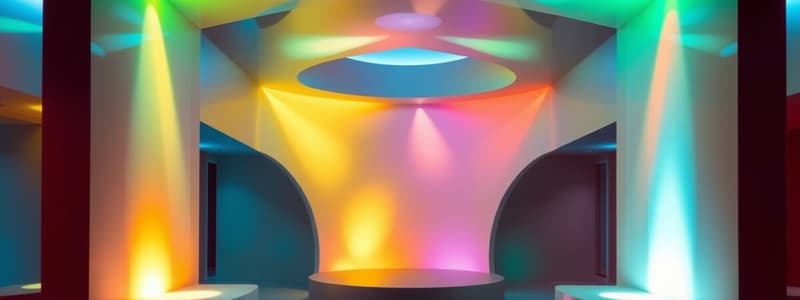Podcast
Questions and Answers
What is the Color Rendering Index (CRI) used to measure?
What is the Color Rendering Index (CRI) used to measure?
- The temperature of a light source
- The brightness of a light source
- The complexity of a light source's spectrum (correct)
- The efficiency of a light source
Which light source has the lowest CRI value?
Which light source has the lowest CRI value?
- Daylight
- Incandescent light
- High pressure sodium (correct)
- Fluorescent light
How is correlated color temperature expressed?
How is correlated color temperature expressed?
- In lumens
- In inches
- In degrees Kelvin (correct)
- In degrees Fahrenheit
What happens to our perception of color when a light source emits more of one wavelength?
What happens to our perception of color when a light source emits more of one wavelength?
Which of the following is not typically used to describe fluorescent sources?
Which of the following is not typically used to describe fluorescent sources?
What does lighting design primarily focus on?
What does lighting design primarily focus on?
What is the primary basis of distinguishing different forms of electromagnetic radiation?
What is the primary basis of distinguishing different forms of electromagnetic radiation?
Which layer of lighting design addresses the creation of mood and ambiance?
Which layer of lighting design addresses the creation of mood and ambiance?
How is the visible spectrum defined in terms of wavelength?
How is the visible spectrum defined in terms of wavelength?
What does phototropism refer to in the context of lighting?
What does phototropism refer to in the context of lighting?
What is one of the properties of electromagnetic radiation (EMR)?
What is one of the properties of electromagnetic radiation (EMR)?
What does the sun provide that is significant for light and energy?
What does the sun provide that is significant for light and energy?
What is highlighted about the effectiveness of light placement?
What is highlighted about the effectiveness of light placement?
What term describes the amount of light striking a surface?
What term describes the amount of light striking a surface?
Which part of the human eye contains all photoreceptors?
Which part of the human eye contains all photoreceptors?
Which type of vision do rods primarily support?
Which type of vision do rods primarily support?
Which cones are sensitive to red light with a wavelength of 580 nm?
Which cones are sensitive to red light with a wavelength of 580 nm?
What defines Luminance in terms of light?
What defines Luminance in terms of light?
Which components are found in the macula and fovea of the human eye?
Which components are found in the macula and fovea of the human eye?
Which color sensitivity is associated with GAMMA 'G' cones?
Which color sensitivity is associated with GAMMA 'G' cones?
What is generally the concern with white light in human vision?
What is generally the concern with white light in human vision?
Flashcards are hidden until you start studying
Study Notes
Understanding Lighting Placement
- Human adaptation to varying light levels influences lighting effectiveness.
- Importance of brightness and contrast affects spatial perception.
- Phototropism demonstrates how plants respond to light direction and intensity.
- Vertical vision is enhanced by strategic light placement, improving spatial awareness.
Layers of Lighting Design
- Chorography focuses on destination-oriented lighting for navigation.
- Ambient or mood lighting employs intensity, color, and texture to evoke feelings.
- Accent lighting highlights specific objects or features, adding visual interest.
- Architectural lighting integrates light with structural design to enhance aesthetics.
- Task lighting provides focused light for specific activities, improving functionality.
Basic Properties of Light
- Light belongs to electromagnetic radiation (EMR), which includes heat, x-rays, microwaves, and UV rays.
- EMR travels at a constant speed, identified as the speed of light; its variation is due solely to wavelength.
- The visible spectrum ranges from 380 nm (violet) to 770 nm (red), representing the portion detectable by human eyes.
EMR and Its Sources
- The Sun is the primary source of EMR, emitting a wide spectrum of radiation, with only certain wavelengths penetrating the atmosphere.
- The visible spectrum, some infrared (IR), and ultraviolet (UV) rays reach the Earth's surface.
Key Lighting Terms
- Lumens quantify light and measure illumination and brightness.
- Illuminance refers to lumens striking a surface, expressed in foot-candles.
- Exitance denotes lumens leaving a surface without directional specifics.
- Luminance is light emitted in a specific direction, relevant to perceived brightness.
Human Vision Mechanisms
- The eye focuses at various distances and adapts to light levels, enabling visibility in different conditions.
- Components of the eye include:
- Cornea: refracts and protects light entry.
- Iris/Pupil: controls light adaptation.
- Crystalline Lens: changes shape for focus.
- Retina: houses photoreceptors divided into periphery, macula, and fovea, crucial for vision.
Photoreceptors in the Eye
- Cones are concentrated in the macula and fovea, responsible for color vision in high light levels (Photopic vision).
- R, G, and B cones detect red, green, and blue wavelengths respectively.
- Rods are located in the eye's periphery, active in low light (Scotopic vision), sensitive to motion and changes in light.
Color Science and Light Sources
- White light is a subjective experience, influenced by the completeness and balance of the light spectrum.
- Color Rendering Index (CRI) measures how accurately a light source displays colors, ranging from 0 (poor) to 100 (excellent).
- Examples: Daylight and incandescent light score 100; fluorescent lights range from 75 to 95; high pressure sodium scores low (25).
Color Temperature
- Color temperature describes the influence of a light source's wavelength balance.
- Expressed in Kelvins (K), it indicates the perceived color of light, based on the behavior of heated black metals transitioning from red to blue.
Studying That Suits You
Use AI to generate personalized quizzes and flashcards to suit your learning preferences.




